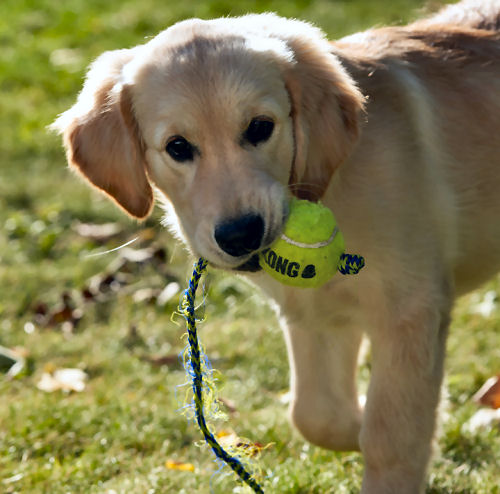You have to be there to train your dog.
It seems obvious, but many people don’t make the crucial connections. Two of our puppy class students had questions this week about “problems” with their dogs. Neither realized they were both asking about the same thing in different situations.
Mitzi is a Golden Retriever puppy, five months old, who has earned the nickname “Destroyer of Toys.” Her dad asked what toys he can get that she won’t destroy. It’s getting expensive to replace them constantly, and, sooner or later, Mitzi’s going to wind up at the emergency vet for swallowing something she shouldn’t.
Bingo is a mixed-breed (Golden x Miniature Poodle) five-month-old puppy who barks a lot. Bingo’s older “brother,” Smokey, is teaching him how, since Smokey (9 years old) watches out the front windows and barks all day long.
You have to be there to train your dog
Both of these families have the same problem, but don’t realize it. They’re attempting the impossible – invisible training.
You can’t train your dog if you’re not there. You can’t solve a problem by ignoring it. You have to be there to train your dog.
Get creative with problem solving
The solution to Mitzi’s problem is really easy, but her people never thought of it. She gets no toys unless they are actively playing with her. This will actually work to solve another issue they don’t realize they have. Mitzi has no interest in her “dad.” She never checks in with him, rarely glances at him, and pays no attention unless she has no other choice. Their relationship is tenuous, at best.

If the only time this toy-obsessed puppy gets to play with toys is when her people are with her, she’ll learn they’re the source of all good things and the bond will grow exponentially. Dogs, especially puppies, don’t have to be busy or entertained all the time. Puppies need lots of sleep and down time. Without constant toy stimulation, Mitzi will have a chance to get the rest she needs to process all the things she’s learning.
Bingo’s a tougher case
Because there’s another, older dog in the house, Bingo is learning both bad and good things from him. To nip Bingo’s barking behavior in the bud, Smokey has to get with the program. And that will depend on how willing his people are to put in the effort.
It seems that Smokey has free run of the house, all day long. He parks himself at the front windows, which are two-stories high, with no blinds.. And he barks at everything he sees, all day long. Bingo is just following Smokey’s lead, learning that barking at everything outside is okay.
Be creative with solutions
Solving the issue requires restricting access to those windows when the family isn’t there to participate in training games. Hope listened to a bunch of “buts:”
- But there are no blinds
- But it’s an open concept house
- But we can’t be there all the time
- But they watch through the rail on the second floor
Hearing about the issue for the first time, listening for only a couple of minutes, Hope came up with two viable solutions: On the first floor, get spring-rods and drape sheets across them so the dogs can’t see out. On the second floor, drape the railing so the dogs can’t see out.
Once they manage access, the “Looky Lou” game is perfect. Let the dogs look out the window. If they start to bark, get their attention and reward for looking at you, instead of the barking trigger. If you’re there to explain what you want, your dog will quickly learn. Train one dog at a time. And yes, the nine-year-old dog can learn, too.
Look at whatever your dog’s issue is from an outsider’s point of view. Say it out loud, or pose the question on social media. Or ask us. There’s always a way to manage the behavior until your training takes effect. Your choices for dealing with your dog’s “naughty” behaviors are one of three: Ignore it. Manage it. Train it.
Mitzi’s and Bingo’s families have been ignoring it. Now they know how to manage it. The next step will be how diligent they are in training to “fix” it.
